Click on the links within this brief
outline for first hand accounts by the men who served on HMS Woolston and for a more detailed chronolgy see www.naval-history.net
HMS
Woolston was one of six Thornycroft W-Class destroyer built at Thorneycroft's Woolston
shipyard on the opposite side of the River Itchen from Southampton. She
was launched in January 1918 and named after the shipyard where she was built. The Woolston made news when she entered Scapa Flow with Harry Hawker and Cdr Kenneth Mackenzie-Grieve
after their unsuccessful attempt to fly across the Atlantic in May
1919. From 1926 - 8 HMS Woolston was part of the 3rd Destroyer Flotilla on the China
Station but in August 1927 she was put in Reserve until 1931. Her CO, Lt Cdr Donal Scott McGrath RN became CO of HMS Wanderer and remained on the China Station with the 3rd DF. On 11 September 1931 HMS Woolston was commissioned at Devonport for service with the First Anti-Submarine Flotilla out of Portland.
In 1939 she
was converted to a WAIR type Anti-Aircraft (AA) escort (her pennant
number changed to L49) and spent most of 1939 - 42
escorting east coast convoys in the North Sea. Her first wartime CO, Lt
Cdr W.J. Phipps RN, described this period in his diary (Imperial War Museum, Docs.7510) and a CW Candidate, Samuel Gorley Putt, described life as a rating on the lower deck of HMS "Tiddley" (Woolston) in Men Dressed as Seamen (1943). In March 1941 Woolston
was transferred to Western Approaches Command at Londonderry as an
Atlantic escort but returned to Rosyth Command escorting east coast
convoys in November 1941. During National Warships Week in February
1942 the
Cheshire town of Congleton adopted HMS Woolston
after raising £220,000, the cost of building the
hull of a destroyer. In March she was
part of the escort for Arctic Convoy PQ.12 and returning Convoy PQ.8.
In June and July of 1943 HMS Woolston (Lt Frederick William Hawkins RN) escorted convoys to Gibraltar and the
invasion beaches on Sicily, Operation Husky.
From 1944-5 she resumed her service as an escort for east coast convoys
and the war artist, Charles E. Turner,
spent some on HMS Woolston
during this period. At the end of the war she made two trips to Bergen, Norway, Operation Conan (part of Operation
Apostle) to accept the surrender of German naval forces. HMS Woolston was paid-off and reduced
to Reserve status after VJ Day and broken up in 1947.
Commanding Officers
With acknowledgement to the Dreadnought Project and Unithistories.com
Officers
This
short list of officers who served on HMS Woolston during World War II all
have entries on the unithistories.com web site.
Further names from the
Navy List will be added later.
| Lt Thomas Johnston RN (April - October 1938) Wartime Officers Lt. A.H.G. Butler, RNVR (11 May 1943 - April 1944) Lt Ian N.D. Cox, RN (31 July - Dec 1941) S.Lt John P.O. Evans, RNVR (15 September 1939 - Dec 1941) |
A. Hugo E. Hood, RN (11 Sept - Oct 1942) Lt(E) C.A. Maxwell, RN (1942/3?) Lt. Herbert A. Taylor, RN (4 March 1943 - Dec 1943) Lt. Basil C.Ward RN (9 Sept 1939 - 13 August 1941) Cd. Gnr Harold West RN (March - April 1930) Lt. Roderick B. Whatley, RN (27 March 1942 - Feb 1943) |
Transatlantic aviators saved by Woolston in 1919
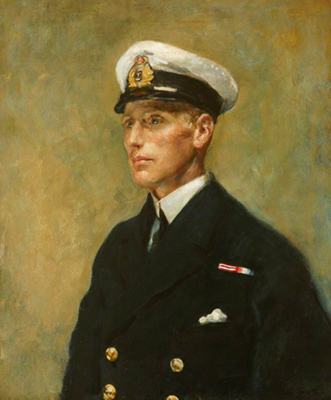
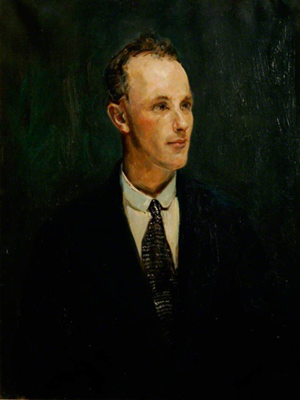 Everybody
knows that John Alcock and Arthur Brown made the first non-stop
transatlantic flight in June 1919 in a modified First World War Vickers
Vimy bomber and the Secretary of State for Air, Winston Churchill,
presented them with the Daily Mail prize for the first crossing of the
Atlantic Ocean by aeroplane in "less than 72 consecutive hours".
Everybody
knows that John Alcock and Arthur Brown made the first non-stop
transatlantic flight in June 1919 in a modified First World War Vickers
Vimy bomber and the Secretary of State for Air, Winston Churchill,
presented them with the Daily Mail prize for the first crossing of the
Atlantic Ocean by aeroplane in "less than 72 consecutive hours".
But they were so nearly beaten by the Australian pilot, Harry Hawker (on left), and his navigator, Lt Cdr Kenneth Mackenzie-Grieve RN (on right), who set off from Newfoundland on 18 May 1919 in their Sopwith biplane named Atlantic but had to ditch in the Atlantic after fourteen hours. They were rescued by the Danish ship, Mary, which had no wireless to report their rescue and it was assumed they died when their plane crashed in the sea.
HMS Woolston, the Navy's newest destroyer, had "short legs" and never crossed the Atlantic but she was in the area and had wireless communication. The Mary transferred the brave aviators to the Woolston who reported their rescue and took them to Scapa Flow. The Illustrated London News carried the news to their readers in their issue of the 31 May:
"The steamer Mary which rescued Mr Hawker and Commander Mackenzie-Grieve RN, was intercepted on May 25th off Loch Erribol by the destroyer Woolston which conveyed them to the fleet at Scapa Flow, where they spent the night on board HMS Revenge as the guests of Admiral Freemantle."
One of Frank Witton's shipmates in HMS Woolston was
"Eboat", the ship's cat. He was a stray black cat who joined ship
at Chatham as a HO only rating and was "adopted" by a Petty Officer at
the end of the war. Alan Witton: "Both dad and E-Boat were on board for his entire time with HMS Woolston so she went to Archangel and Sicily". He certainly deserved a medal for all the hardships
he suffered but was popular on the lower deck though less so with the
CO. On one stormy day at sea Eboat lost his paw-hold, was swept
overboard and the cry, "cat overboard" rang out about the ship. The
captain on the bridge turned the ship round and, miraculously, Eboat
was rescued from the foaming-brine. He was frozen and exhausted and had
to be wrapped in a blanket and put in an oven to recover.
He was actually a "she" and led a lonesome life at sea and an attempt was made to find her a companion but the cat selected was a poor sailor, suffered dreadfully from sea-sickness under the hard-lying conditions endured by all the V&Ws and, at the first opportunity, jumped ship and Eboat was back on her own again. She was always a favourite with the sailors who made a great fuss of her but, sadly, I am still waiting for somebody to send me her photograph.
 |
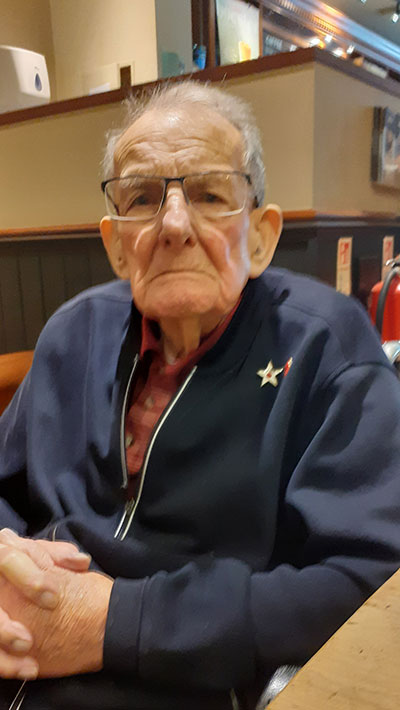 |
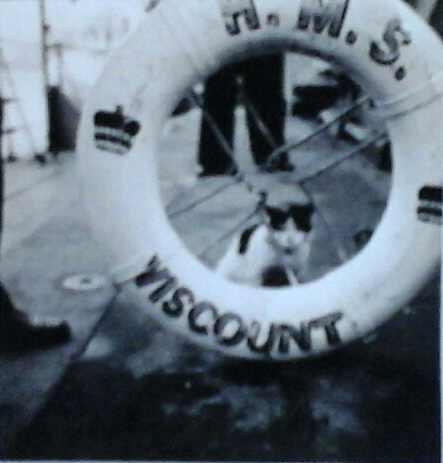 |
Sadly, their names are not recorded and their service certificates have not been traced.
I would like to acknowledge Frank Witton for the story of his old shipmate - you can read Frank's own story below
The men in HMS Woolston tell their stories
Frank Witton
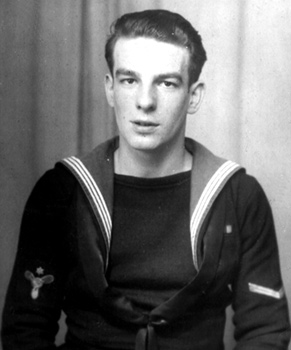 |
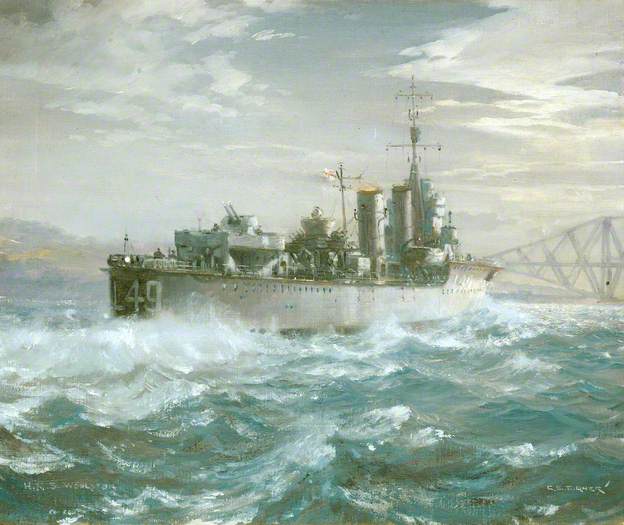 | 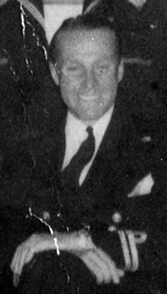 |
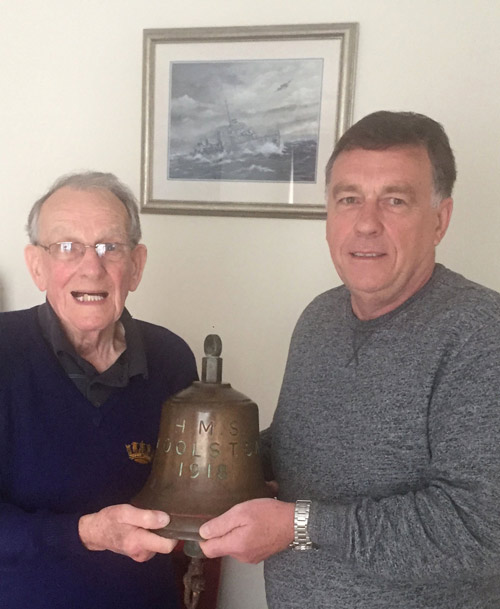 |
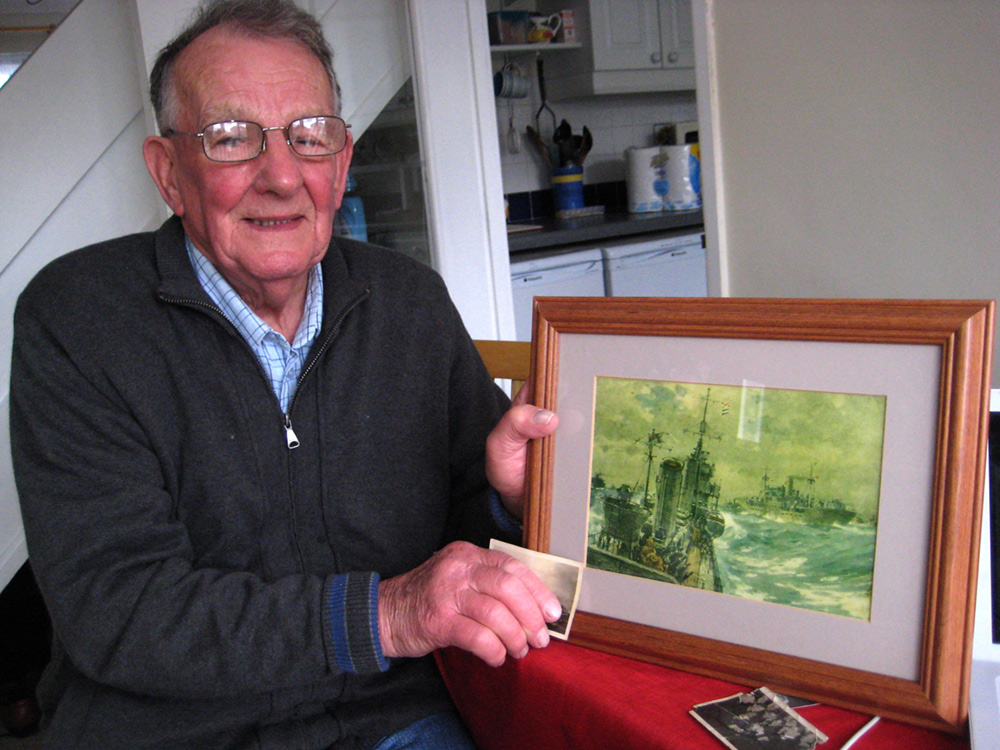 |
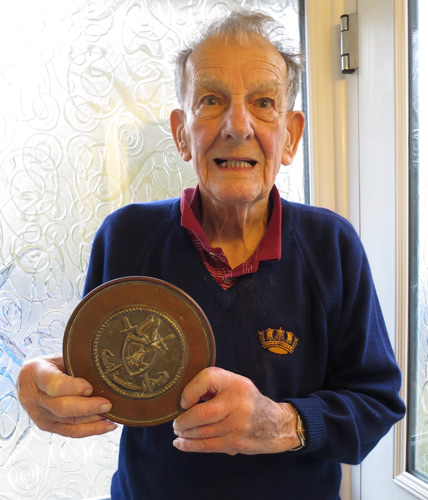 |
Frank Witton at his home in St Albans
in 2013 holding a print of a painting of HMS Woolston by Charles E. Turner who
spent some time on Woolston
Left: Alan Witton bought the ship's bell of HMS Woolston in North Carolina, USA, and flew to Britain in May 2019 to present it to his father on the anniversary of Woolston liberating Bergen
Right: Frank Witton holding one of the bronze tompions which covered the barrel of Woolston's 4.7 inch main guns, October 2019
Photographed by Bill Forster in St Albans where Frank was born 99 years ago
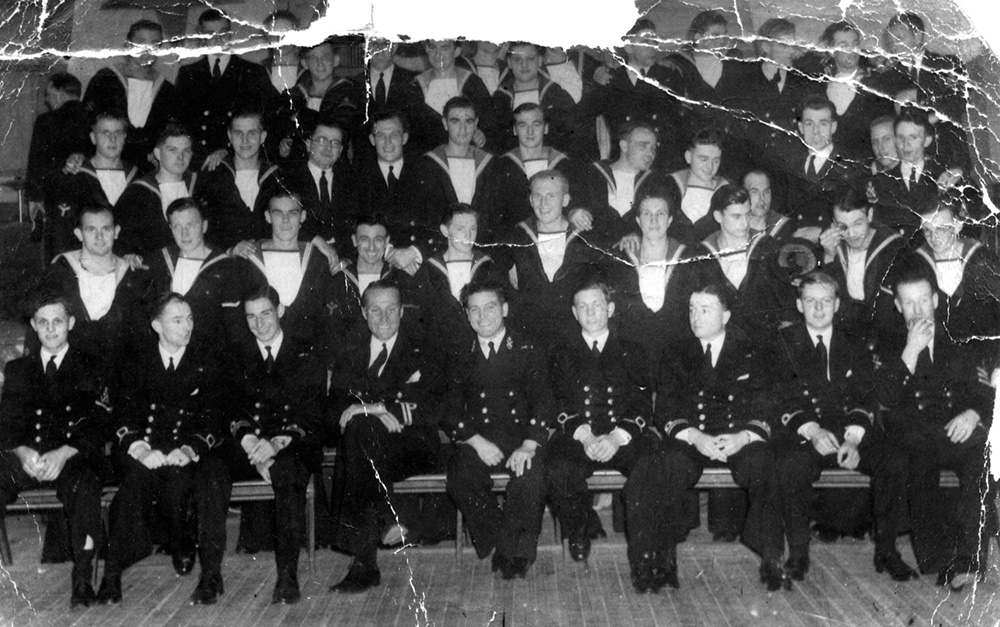
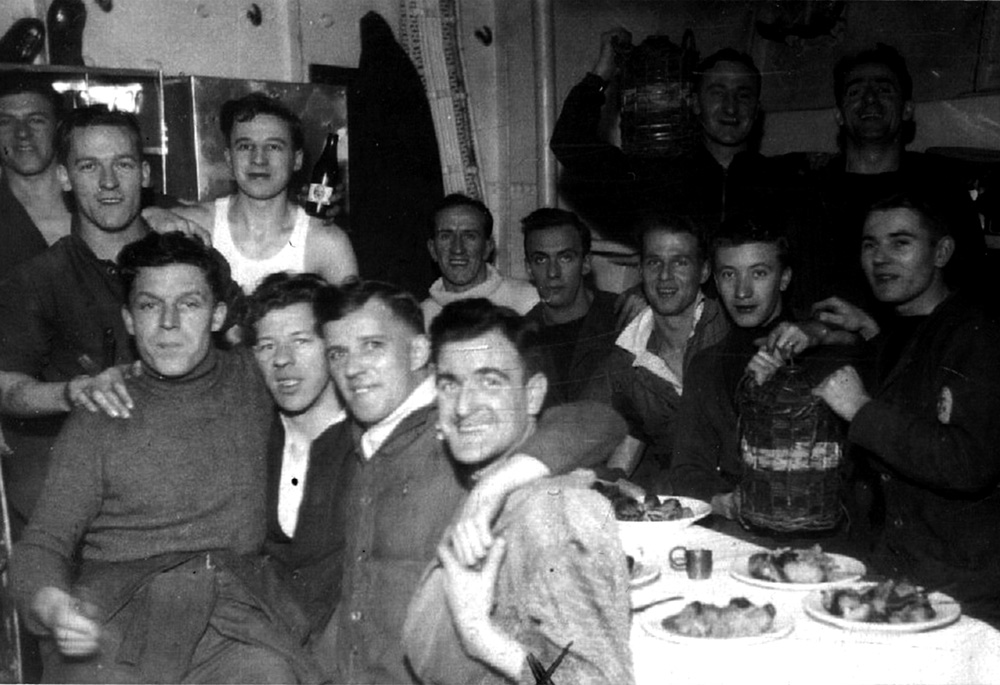
Cod, dried biscuits and rum for
Christmas Dinner on the stokers' Mess Deck, HMS Woolston, in 1942
The CO ordered two depth charges to be dropped and they lowered
a boat to collect the cod covering the sea
Neil O'Rouke from Glasgow is centre nearest the camera, Bill Perry
holds a
binnacle lamp and Jack Boore and "Spider" Kelly
are seated holding the keg of rum
Also in the photograph are "Smokey" Meadows and Ronnie Barnes
Courtesy of Frank Witton
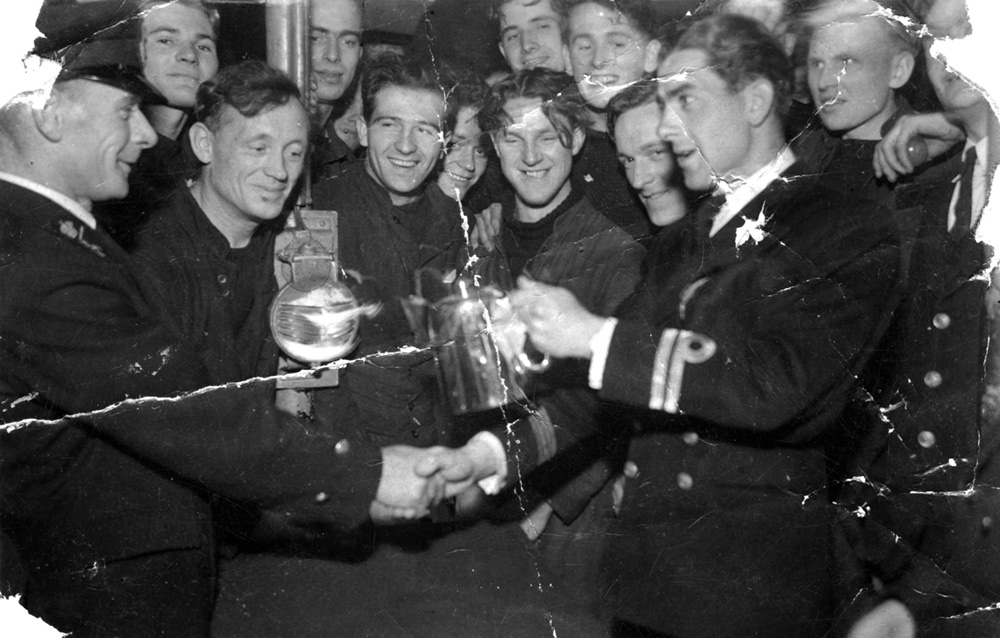
The Coxon presents a silver teapot as
a wedding gift to First Lieutenant Bingham on HMS Woolston
Bill
Perry, Stoker, is second left and "Smokey" Meadows is on Lt Bingham's
left
Courtesy of Frank Witton
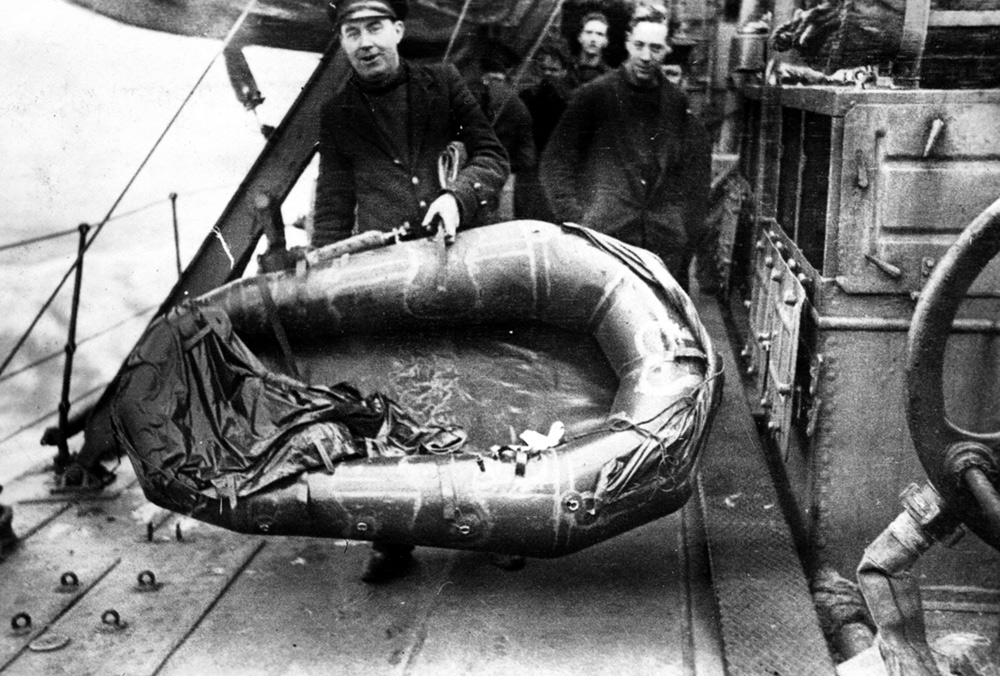
The dinghy of an allied airman rescued
by HMS Woolston
Courtesy of Frank Witton
Bill Forster recorded an interview with
Frank Witton at his home in St Albans in 2013
You can click on the link to listen to Frank describe his wartime service on HMS Woolston
The recording is on the website of the Imperial War Museum
Jack Boore tells his story on the BBC Peoples War web site: http://www.bbc.co.uk/history/ww2peopleswar/stories/08/a2070208.shtml
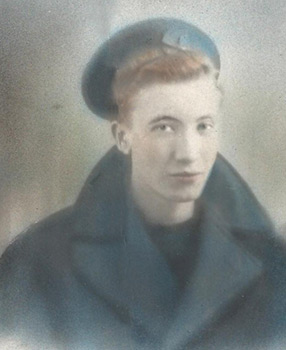
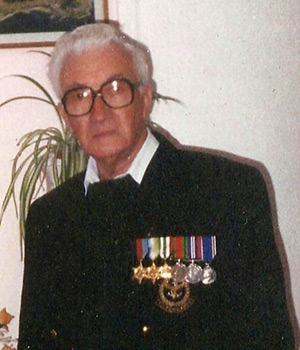 I
spent my nineteenth birthday square bashing, not a very good day! Six
weeks
later came reality, posted to Royal Naval Barracks, Chatham. My
introduction to HMS Pembroke
came as a shock, thousands of sailors in barracks and on ships in the
dockyard, whistles blowing if you happened to be on the wrong side of
road, i.e. officers only area, yelling orders and doubling across
massive parade ground, fire fighting school, gas school, working in
boiler or engine rooms that were on the ships in dockyard and many more
tasks I never dreamed of.
I
spent my nineteenth birthday square bashing, not a very good day! Six
weeks
later came reality, posted to Royal Naval Barracks, Chatham. My
introduction to HMS Pembroke
came as a shock, thousands of sailors in barracks and on ships in the
dockyard, whistles blowing if you happened to be on the wrong side of
road, i.e. officers only area, yelling orders and doubling across
massive parade ground, fire fighting school, gas school, working in
boiler or engine rooms that were on the ships in dockyard and many more
tasks I never dreamed of.
After
this chaotic routine I was posted to a mine sweeper at
Grimsby. The boat was in the midst of a refit, pipes wires and hoses
cluttered the decks, my vision of a sleek modern destroyer or cruiser
was shattered, the ship was filthy, so, as you can imagine I was not a
happy sailor. Four days later the German air force bombed Grimsby naval
area, a bomb fell next to the ship causing damage so, once again pack
bag and hammock and return to the navy barracks at Chatham. That was
the
only time in my life that I was pleased to see the Germans. A few weeks
later ordered to drafting office, five of us were posted to HMS Woolston,
a 1917 destroyer based in Scotland, so I packed my kitbag and hammock
and was off once more. We travelled all night and arrived at
Inverkeithing the next day.
HMS
Woolston was at sea and we
were put onboard HMS Cochrane,
a depot ship in Rosyth. A few days’ later plans were changed, HMS Vortigern
was to be my assignment; I packed my worldly possessions and went to
Vortigern, unpacked my gear
and settled down in my new home (so I
thought). A few days’ later plans were changed again!!! HMS Woolston arrived in harbour, lots
of activity in harbour, ships getting ready urgently to go to sea. I
was ordered to join HMS Woolston,
once again I packed my gear and went aboard my original ship. We were
topped up with oil and ammunition.
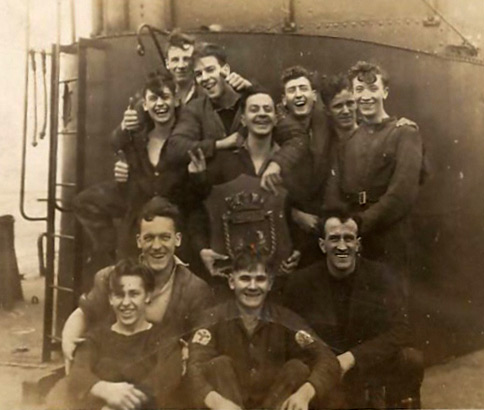
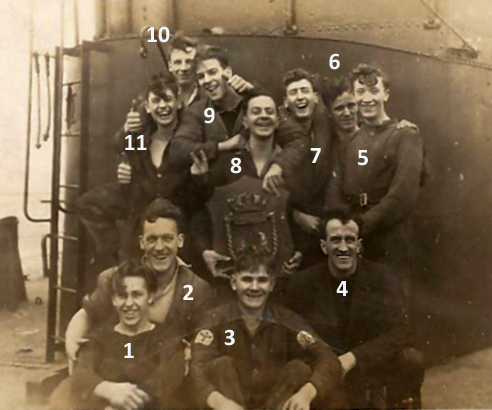
"The
Dustmen in a group on a windy day": the Stokers after a boiler clean holding the ship's crest
The photograph includes:
"Smokey" Meadows (2), "Flash" Bowman (11), Ronnie Barnes (10), Frank
Witton (9), Sid
Winch (8), Stan Bister (7), Jack Boore (5) and Bill Perry (3) plus
Frederick Alexander
MacIver, A PO Supplies (4), who shared their Mess
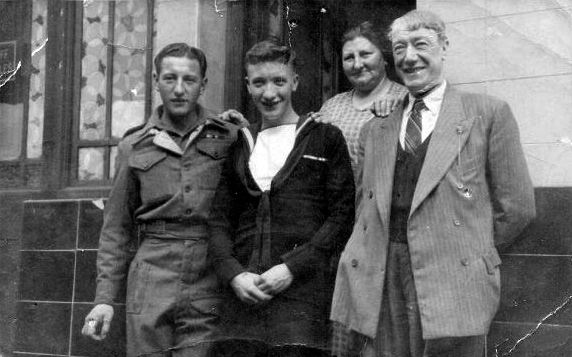
Left: Jack Boore home on leave with
his parents, Fred and Liz Boore, and his brother Albert home from Burma
Courtesy of John Boore
The German battleship Tirpitz had left her base in Norway and all available destroyers in our area were dispatched to intercept her. We then began a chase at full speed up into arctic waters. Not a nice initiation into life in the Royal Navy (the thought of Bear Island still makes me shiver). Fortunately we never sighted the Tirpitz, apparently she got information about a fleet at sea to intercept her and Tirpitz, to our relief returned to Norway.
Shortly after our return to Rosyth we heard the tragic news that HMS Vortigern had been torpedoed by
German E-boats off the East coast and out of a crew of 212 only 12
survived. Lady luck was with me.
Sixty nine V&W Class destroyers were built during the First
World War, the ships' names all began with V or W. Modesty and privacy
was
forgotten as soon as you arrived on these ships, washing facilities
consisted of five hand basins in a room no bigger than a broom
cupboard, and toilets were five stalls (no doors) for about 160
ratings,
fortunately being engine room branch our clothing at sea was minimal
i.e. a
boiler suit over our underwear. Washing was done in a
bucket and put to dry in the boiler room above the boilers. The seamen
often never took their clothes off on putting to sea.
Life
was
horrendous, trying to get along the deck to your place of duty,
boiler or engine room during rough seas, or trying to have a meal when
sometimes the side of the ship was above your head was beyond
description. The stokers' mess deck was forward on ship, down a round
hatch about 36” diameter, twenty-two ate and slept in an area no bigger
than an
ordinary living room, if action stations sounded there was a mad rush
to get out as soon as possible. When in northern waters condensation
poured down the side of the ship,
giving permanent damp conditions , if in the Mediterranean area
the air conditioning was insufficient to keep cool, so one went from
one hell to another, it wasn’t unusual to be in Arctic waters one month
and then in the Mediterranean a month later.
HMS Woolston was my home
for
three years. Atlantic convoys, Arctic, North Sea Convoys, patrols in
Northern waters, Mediterranean, North Africa, Italy and the Sicily
Invasion. Joining as a 2nd class stoker on 2/- a day (10p),
leaving as a Leading Stoker. I returned to Chatham and then got posted
to HMS Suffolk
a 10,000 ton cruiser going out to Australia. War ended as did my four
and a half years service in the Royal Navy. For my efforts I got £83.
Jack Boore was 90 when he died in March 2013 and
never forgot his time on HMS Woolston
His son John followed him into the
Royal Navy and retired as a Chief Petty Officer after 25 years service
HARD LYING
Conditions on V & W Class
destroyers were so bad in rough weather that the men who served on them
were paid hard-lying money. These stories by veterans who served on
HMS Woolston were published in Hard Lying,
the magazine of the V & W Destroyer Association and republished in
2005 by the Chairman of the Association,
Clifford ("Stormy") Fairweather, in the book of the same name which is
now out of print. They are reproduced here by kind permission of
Clifford Fairweather and his publisher, Avalon Associates. Copyright
remains with the authors and
photographers who are credited where known.
G Hutchinson describes conditions on HMS Woolston
"On
the 15th July 1944 I was posted to HMS Pembroke
to await my first sea posting. I purchased a gold wire
winged flash of lightning to sew on the right arm of my best Naval suit
to indicate that I had now passed out as a R.A.D.A.R. Operator.
Although not permitted in peace time, the ‘in' thing for the war time
sailors was to be 'tiddly'. This meant, first of all to form a near
'tiddly' bow on the cap band by sewing a small button in the centre of
the bow, and instead of wearing the bow over the left ear as per
regulations it would he next to the HMS on the hat band and whilst on
leave the hat would be worn on the back of the head, something that you
would not dare do whilst in barracks.
Next the collar, with the three white stripes attended to, the issue
collar was dark blue, so we would bleach it to attain a lighter blue,
then you did not look like a 'sprog' who had just joined, and to give
the impression that you had served in some warmer climes and your
collar had been bleached by the sun. The tunic issue had a distinct 'V’
cut in the front which we cut to a 'U’ shape, and the silk neck piece
would be tied in a 'tiddly' bow at the front. The tunic was also
machined in at the waist to give a tighter fit. The bell bottom
trousers when issued would have 22 inch bottoms, these would have a 4
inch gusset in each leg to give a 26 inch bottom, then to finish off
the trousers would be given a good press with seven horizontal creases.
Those who could afford to would go to a naval tailor and have all these
modifications carried out professionally, then you would keep your
'tiddly suit' for going ashore or on leave only.
Whilst in Chatham barracks we were kept busy square bashing, peeling
spuds, mess cleaning, white line washing and generally having our
bodies and minds occupied. Walking across Chatham parade ground was not
permitted, everything had to be done at the double, otherwise it was at
your own peril and you would find yourself with stoppage of pay or
stoppage of leave.
I enjoyed some weekend leave whilst there, until I was posted to HMS Woolston
at Rosyth dockyard on the 24th September. I caught the train from Kings
Cross to Waverley station Edinburgh. Struggling with my kit bag and
hammock and weekend case I caught the next train to Inverkeithing,
seeing, and crossing the Forth Bridge tor the first time. When I
finally arrived at Rosyth dockyard I had to catch a Naval tender to the
Woolston who was anchored in
mid stream. I was accompanied by another ordinary seaman, Roy Cantwell.
No sooner had we been detailed to the forward port mess deck, stowed
our kit bags and hammocks, when we were told that we could go ashore
until 230O; Roy and myself took up the offer, even though we had been
traveling all day, so back we went to Edinburgh. On our return we
found that we had to kip down on the port side lockers because there
was insufficient room to sling our hammocks.
Early next morning reveille was piped at about 0500 and after getting
dressed we had to muster with the other seamen on the forecastle port
side as an equal number, eight men, were lined up on the starboard side.
We weighed anchor or slipped the buoy. It was very calm, but I had not
yet found my sea legs and found it very difficult standing still as HMS
Woolston slowly made her way
under the Forth Bridge out into the Firth of Fourth and on in to the
North sea to escort a convoy going South. For the next three days I was
seasick and did not feel too good, as a
matter of fact I wished that I had never joined. Some of my mess mates
did not mind, because they helped themselves to my rations.
Woolston was an old V&W destroyer built in 1918 by Thornycrofts,
her recognition and pennant number which was L49 was painted on her
sides just forward of the break in the forecastle.
There was a steam capstan in the mess deck and for this
inconvenience
we were entitled to an extra I/- a day classified as Hard Lying money.
The stokers and artificers mess was just below the seamen's mess. Just
forward of the break in forecastle and between the port and
starboard gangways was situated a small cooks galley, two members from
each mess would prepare the food and take it to the galley for the cook
to do his duty. The heads (toilets) and washrooms were situated
between the bulkheads
from the break of the forecastle to the mess decks. You could not
afford to be shy when using the toilets, because the partition between
the pans were so low that you could pass the time of day with you
'oppo' sitting on the next pan. The officers’ quarters and wardroom
were situated aft.
HMS Woolston was armed with
twin four-inch gun turrets fore and aft coupled with rocket launchers.
On port and starboard amidships were single Bofor guns. For submarine
warfare there were depth charge rollers astern and depth charge
throwers on both starboard and port quarters. There was an Asdic set
plus two radar sets, one amidships and one just above the bridge.
Invariably there would be three escort vessels on patrol and
occasionally four. Sometimes we would have the old American four
stackers which had been transferred under the Lend Lease Agreement.
During theses escort duties I would spend my watch on the midship radar
set. This set did
not have a cathode ray tube which showed a circular sweep. Instead it
depicted echo's in a straight line with blips bobbing up and down. One
could distinguish between low flying aircraft and ships. I would also
do a watch on the forward gun turret. In the winter, one of the crew
would go down to the galley and bring back a jug of 'Kye'. It was a
very thick chocolate drink which was made from scraping a solid block
of this special chocolate into a 'fanny' and adding water, then brought
to the boil, depending on who made it, it could be thick enough to
stand a spoon up in it.
At times we would have a little quiet sing-song among the gun crew, but
we would get a very curt command from the bridge if we raised our
voices too high. It was different when I was on the radar set, for I
would be alone for
four hours, just watching the echo's bobbing up an down on the screen
and only reporting if there was anything suspect occurring.
The washing of clothes or 'dhobeying' would be done in a bucket and was
either hung amidships between the two smoke stacks or hung down in the
engine room to dry. At sea we were permitted to wear overalls as rig of
the day, with
leather sea boots which reached up to the knee and thick white sea boot
stockings which were turned over the top of the sea boots, but as soon
as we sailed into harbour it was back to Naval uniform.
It could be very cold on convoy and if the weather was bad, as it often
was, the heavy seas would wash over the destroyers low deck line from
the break in the forecastle to the stern. I was fortunate to be one of
those recipients of one of the lambs wool lined leather coats donated
by South Africa. Also in rough weather, life-lines would be rigged from
the break in the forecastle to the stern. On these lines would be short
lengths of rope with an eye splice and thimble, so that anyone walking
along the deck could do so with reasonable safety.
There were times when the convoy would come to a complete standstill
due to thick fog. The escort vessels had radar, but not all the
merchant ships were so well equipped, I can remember one day when I was
on duty on the forward gun turret, in one of the lay-to situations when
a submarine
conning tower just slid past our bows. I can only assume that it was
one of ours. On other occasions the nearness of the enemy became was
plain to see. Action stations would be sounded and then some
unfortunate merchant ship would receive the full force of an exploding
torpedo and within minutes would be going down to the bottom. Sometimes
action stations were not sounded until the first torpedo had struck. In
either cases it would be full steam ahead and as soon as the depth
charges had been set, they were either rolled off the stem or fired
from the quarter throwers.
From the time I joined the Woolston
to the end of the war with Germany I think we only had one possible
sinking of a U-boat. We saw oil and clothing come to the surface,
but as that was a ploy played by both sides to mislead the attacking
surface ships, it could not be classified as a kill only a probable.
When we eventually returned to the mess deck, we would find that the
enormous pressure of the exploding depth charges had stressed the
ship’s riveted plates and she had let in water. Another consequence of
depth charge explosions were that some of the hammock slinging bars
would snap and some of the matelot's would have to find somewhere else
to sleep. I had to wait four or five weeks before I was allocated a
berth when one of my shipmates was drafted off the ship. The hammocks
were so closely slung that we were virtually in one large swaying bed.
To avoid breathing each others breath we used to sleep alternately head
to foot.
If there happened to be action stations during the night, we would
immediately come awake, grab some clothes and run like mad to our
action stations. On one occasion a German E-boat sped up between the
lines of the merchant ships, firing its torpedo's and guns. There was a
bit of a 'ding-dong', but no major hit, just shell holes in the ships
funnels and side. Sometimes the rough sea would free mines from their
moorings and these
floating hazards would give the gun crews some extra practice.
We were granted four free travel warrants each year, so when the Woolston
went into Leith dockyard for a refit I used one for some home leave.
The train journey from Edinburgh took some 8 to 9 hours overnight, the
train was always completely crowded with service personnel going on or
returning from leave. When the train pulled into Kings Cross it was an
experience to see the number of service men who had no ticket, with
just one or two ticket collectors on duty, they had no chance to slop
the surge of passengers, some would jump over the barriers or would
offer any piece of cardboard that looked like a ticket. Most of the
ticket collectors could not care less as they probably had some member
of their family serving in the forces anyway. Some of the servicemen
would just push their way through the barrier without offering tickets
or fare.
In early May 1945 HMS Woolston
with another six destroyers left Rosyth and headed towards Norway.
Memories of HMS Woolston by A.M. Lee
An anonymous contribution to Hard Lying, the anthology of articles first published in the newsletter of the V & W Destroyer Association
"Woolston was among the Naval vessels that took part in the invasion of Sicily, and celebrated her birthday by escorting a convoy to the landing beaches. Once the ships were safely in, her job was to patrol for lurking U-boats and stand by to give a blazing reception to enemy aircraft which might try to interfere with the convoy.